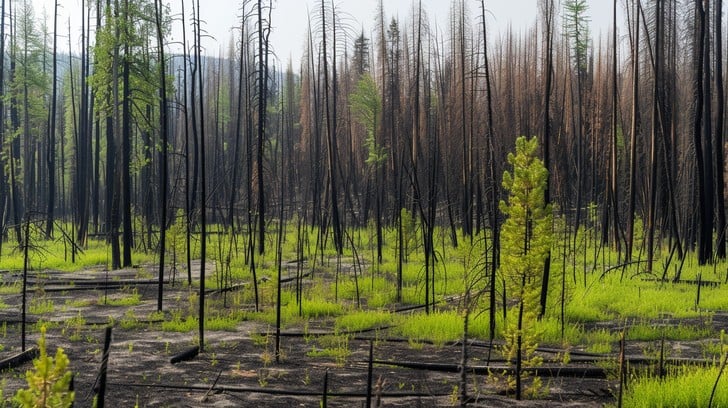Wildfires are becoming increasingly destructive, with devastating consequences for both the environment and the communities affected. However, amid the destruction, something remarkable is happening: people are finding new ways to recover, rebuild, and restore ecosystems. As communities and ecosystems rise from the ashes, innovative approaches to eco-recovery after wildfires are gaining momentum. This article delves into how wildfires are inspiring these cutting-edge recovery methods, ultimately giving hope for a sustainable future.
The Unseen Benefits of Wildfires: A Catalyst for Renewal
At first glance, wildfires seem like purely destructive forces of nature. They burn through forests, disrupt wildlife habitats, and harm human settlements. Yet, these fires can also have surprising benefits for nature. Over time, wildfires can clear dead vegetation, making way for new growth and restoring soil nutrients. But it’s not just nature that’s bouncing back; humans are taking inspiration from these natural cycles to innovate eco-recovery methods.
The concept of “eco-recovery after wildfires” isn’t just about planting trees or restoring habitats. It’s about understanding the dynamics of ecosystems and finding ways to help them regenerate in the face of massive environmental destruction. With a deeper understanding of these processes, scientists, conservationists, and communities are developing strategies that go beyond traditional restoration methods.

Community Innovation Sparks a Greener Tomorrow
As wildfires rage, local communities often bear the brunt of the damage. Yet, these very communities are now at the forefront of pioneering eco-recovery initiatives. Rather than simply rebuilding what was lost, many are embracing sustainable methods that promise long-term ecological health.
Community-Led Reforestation Projects
One of the most powerful tools in eco-recovery after wildfires is reforestation. However, it’s not enough to just plant trees in affected areas. Communities are now focusing on reforesting with a mindful approach, selecting native species that will thrive in the changed environment. This ensures a more resilient ecosystem that can withstand future fires. By planting diverse species that promote soil health and provide food and shelter for wildlife, these projects help create a balanced environment in the aftermath of fire.
In areas like California, volunteers and local organizations are teaming up to restore forests and scrublands. These initiatives are not only rejuvenating the landscape but also providing economic opportunities for communities. Local businesses are benefiting from the work of these reforestation efforts, which also offer jobs and educational programs to raise awareness about the importance of sustainable land management.
Fire-Resistant Landscaping and Green Infrastructure
Another innovative eco-recovery approach is the adoption of fire-resistant landscaping. As wildfires become more frequent and intense, homeowners and cities are rethinking how they design their green spaces. Eco-recovery after wildfires now involves creating firebreaks and planting fire-resistant plants in urban and suburban areas. By reducing the risk of future fires, these measures help protect both lives and property.
Green infrastructure, such as green roofs, rain gardens, and permeable pavements, is also gaining traction as part of the recovery process. These sustainable designs reduce the heat island effect, mitigate stormwater runoff, and foster biodiversity in urban areas. They are becoming essential components of eco-recovery strategies, turning cities into more resilient, fire-ready spaces.
Tech-Driven Recovery: Tools That Accelerate Healing
Technology plays a significant role in speeding up the process of eco-recovery after wildfires. From advanced satellite imagery to drone-assisted planting, innovative tools are making recovery efforts faster and more effective.
Satellite Imagery for Damage Assessment
One of the first steps in eco-recovery after wildfires is to assess the damage and identify areas most in need of attention. Satellite technology is helping scientists and recovery teams pinpoint areas of land that have been most affected. This data helps guide restoration efforts and track the progress of ecological recovery over time. By using remote sensing, recovery teams can monitor the health of plants, soil, and wildlife across vast areas, ensuring that restoration efforts are targeted and efficient.
Drones Assisting in Reforestation
Drones are another technological marvel being used in eco-recovery after wildfires. They are equipped with seed pods and can fly over difficult terrain, dropping seeds in remote areas that might be inaccessible by foot. This method not only speeds up the reforestation process but also ensures that seeds are planted in areas where they are most needed. By harnessing drone technology, recovery efforts can cover larger areas in less time, resulting in faster regeneration of ecosystems.

The Role of Policy and Funding in Eco-Recovery
While local efforts play a crucial role in eco-recovery after wildfires, support from higher levels of government and private institutions is essential for long-term success. Policymakers are increasingly recognizing the importance of investing in ecological recovery and adaptation strategies.
Governments and international organizations are providing funding for wildfire-affected areas, supporting initiatives like forest management, community engagement, and habitat restoration. Policy frameworks are also being updated to include wildfire risk reduction and recovery planning as integral parts of environmental management.
Additionally, private organizations and non-profit groups are partnering with government bodies to scale up eco-recovery efforts. Through public-private partnerships, these initiatives can leverage more resources and expertise, ensuring that recovery efforts are sustainable and impactful.
Looking Ahead: Building Resilience Through Eco-Recovery
Eco-recovery after wildfires is about more than just healing the scars of the land. It’s about fostering a new relationship with nature—one based on sustainability, resilience, and innovation. As communities and ecosystems rise from the ashes, the lessons learned during these challenging times can shape the future of environmental stewardship.
By embracing reforestation, fire-resistant infrastructure, and cutting-edge technology, we can build a future where wildfires no longer devastate, but instead inspire a stronger, more resilient planet. With each recovery effort, we inch closer to a world where nature can regenerate and thrive, even in the face of adversity.
Conclusion: Rising from the Ashes
Wildfires, while destructive, are providing a unique opportunity for growth and innovation in eco-recovery. Through community-led efforts, technological advancements, and supportive policies, we can turn the devastation caused by wildfires into a springboard for ecological renewal. As we continue to explore new approaches to eco-recovery after wildfires, we are not just rebuilding what was lost; we are creating a better, more resilient world for generations to come.







More Stories
Maithili Thakur: From Folk Singing Sensation to Rising Political Star
Mysuru Dasara: The Royal Festival of Karnataka – History, Culture, and Celebration
Blood Moon Over Sydney: Unveiling the Celestial Show with Telephoto Magic